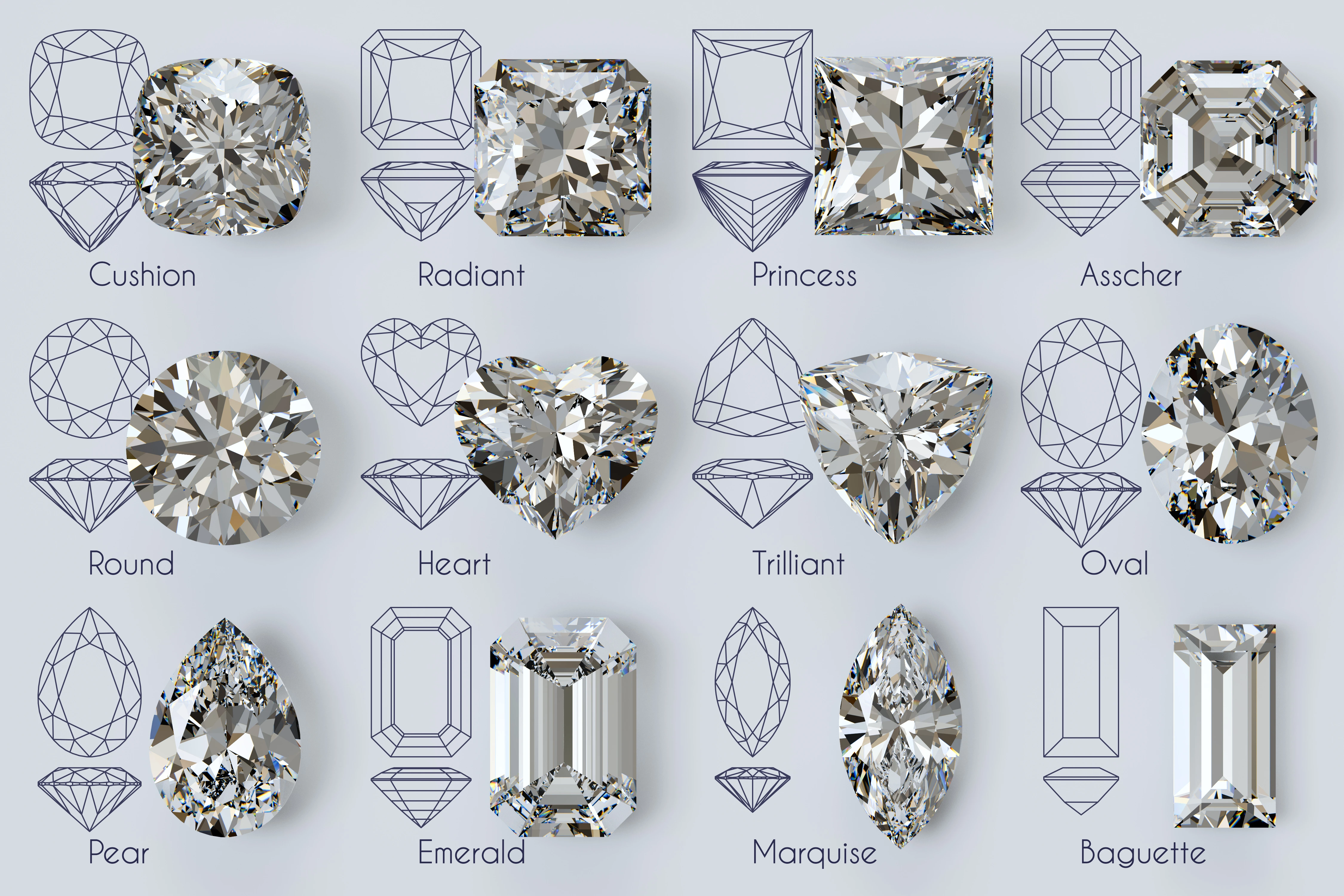Diamond Shape Guide
The shape of the diamond is distinct from the cut. Whereas the diamond cut determines how well-crafted your stone is, the diamond shape refers to the finished piece and the shape it takes.
The choice of shape is a personal one, so make sure you shop around to get an idea about what is available for your budget.

A Guide to Diamond Shapes
The most common shape is Round Brilliant, which has 58 facets. They have higher brilliance and scintillation and are seen as a timeless fashion. However, one thing to consider is that rounder diamonds result in more wastage during the cutting phase, so be prepared to pay extra for what is a slightly smaller end product.
There are a number of other more elaborate shapes that it is important to be familiar with. They are:
Diamond Shape
Shape Princess

Princess
Square cut and with similar refractive interactions to the round brilliant. This is fast becoming a popular style due to its high brilliance and unique aesthetic.
Shape Marquise

Marquise
A long and slender shape that dates back to the days of Louis XIV. It is perfect for increasing the carat size in a given setting.
Shape Emerald

Emerald
A rectangular shape that evokes feelings of elegance and royalty.
Shape Pear

Pear
A teardrop shape that is commonly used in pendants and rings.
Shape Heart

Heart
The quintessential display of love and romance.
Shape Oval

Oval
An elliptical stone with very high brilliance.
Shape Oval

Asscher
A square with deep-cut edges that are highly sought after due to its added layer of depth and sophistication.
When making the final decision on which shape you want to carry with you for a lifetime, don’t be afraid to put the popular trends to one side and choose something you have fallen in love with. The diamond shape is a personal choice and one that, at Abelini, we can help you make in a way that indeed does work for you.
FAQs
A diamond shape is a geometric form characterised by four straight sides of equal length, arranged in a way that resembles a stretched-out square. It has two pairs of opposite angles that are congruent and its diagonals intersect at a right angle. The diamond shape is often associated with the precious gemstone also called a diamond, which is commonly used in jewellery.
The best shape to get a diamond depends on your personal preferences and taste. There are various diamond shapes available, such as round, princess, emerald, pear, and more. Each shape has its own unique beauty and characteristics. It's important to consider factors like style, design and budget when choosing the best shape for a diamond.
A diamond shape refers to the overall outline or silhouette of a diamond, such as round, princess, or emerald. Diamond cut, on the other hand, refers to the quality of how well a diamond has been faceted and shaped, affecting its brilliance, sparkle and overall beauty. While shape describes the form, cut focuses on the craftsmanship and proportions of a diamond.
The diamond's shape significantly influences its sparkle. Brilliant-cut diamonds, such as round or princess cuts, are known for their exceptional sparkle due to their numerous facets that reflect and refract light effectively. On the other hand, fancy-shaped diamonds, like emerald or marquise cuts, may have fewer facets and different facet arrangements, which can affect the dispersion of light and alter the overall sparkle.
Diamond shapes with brilliant cuts, such as round, princess, and radiant, tend to sparkle the most. These shapes have multiple facets that reflect and refract light, enhancing their brilliance and scintillation. The precision of the cut is also crucial in maximising a diamond's sparkle. While other shapes may have their unique beauty, these brilliant cuts are known for their exceptional sparkle and fire.
The largest diamond shapes are typically the ones with a larger surface area. Among popular diamond cuts, the round brilliant cut tends to maximize light reflection, making it appear larger. Other shapes that can showcase size include the oval, cushion, and pear cuts. However, it's important to note that the actual size of a diamond depends on its carat weight and individual proportions.
The shape of a diamond is determined by the way it is cut. Skilled diamond cutters shape diamonds into various forms, such as round, princess, emerald, or pear. The cutter's expertise and precision play a crucial role in achieving the desired shape, which ultimately defines the diamond's appearance and brilliance. Diamond grading institutions also provide guidelines and standards for categorizing diamond shapes.
The round brilliant cut diamond generally holds the best value due to its high demand and popularity. Its optimal light reflection and brilliance make it a timeless choice for many buyers.
The shape that typically commands the highest price is the rare and exquisite fancy-shaped diamond, such as the emerald cut, asscher cut, or marquise cut. These shapes require skilled craftsmanship and result in unique, elegant stones sought after by collectors and connoisseurs.
For larger fingers, elongated shapes like the oval or marquise can create the illusion of longer, slender fingers. These shapes help to visually balance the proportions of the hand and enhance its overall appearance, making them a favourable choice for individuals with larger finger sizes.